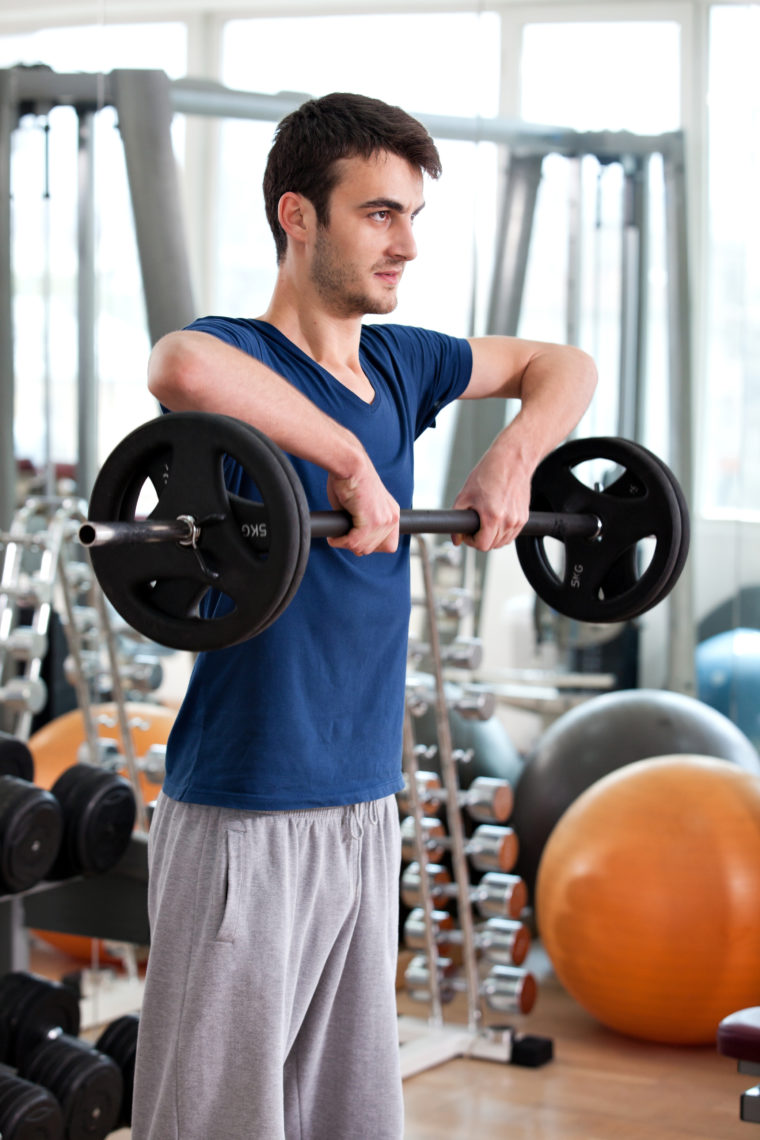I’ve written and taught on the topic of the exercise called the ‘Upright Row’ many times in the past. Sadly, people are still performing this most awkward and dangerous exercise. I guess I will try to keep reaching as many people as possible about this movement. It is responsible for too many injuries. This blog falls on the heels of a prior blog about ‘side deltoid raises’ and the issue of impingement.
The upright row is responsible for shoulder damage. I cannot tell you how many times I’ve seen injuries occur right in front of my face with people performing this exercise. Ouch! Let’s look at the picture above and break it down!
The upright row movement is a flexion/abduction movement of the shoulder rolled in with internal rotation and a bit of retraction, all while under load. What does this do for your shoulder? Well, nothing too much on the good side and a lot on the bad side (meaning, it’s bad). This movement is notorious for impinging the supraspinatus muscle. It just so happens that the supraspinatus is the most damaged rotator cuff muscle. The more distal fibers lie under the acromion process.
There are 3 types of acromion process shapes. First, Type I is flat. This is the best shape to have but most of us do not have this. Second, Type 2, is also known as curved. Third and final, is Type 3, or beaked. Type 2 and 3 are the ones that create impingement and unfortunately, most of us have one of these types. In fact, over 60% of people have a Type 2 or 3 acromion. As alluded to before, this means that we have a high probability of digging the acromion process into the supraspinatus muscle if we bring our arms up to the side (coronal plane).
Throw in the sub-acromial bursa damage that occurs as well and you have hot mess for an injury. ‘But hey, all the guys in the gym are doing it and it creates such a great burn for my shoulders.’ As for the people who think it’s ‘better’ on the Smith Bar machine, guess again…go ahead and rip that supra! (not!)
Ask someone performing an ‘upright row’ what they are training, and you’ll get a whole host of answers. Many think it’s for the upper trapezius (why would most people want to train these anyway), the deltoids, supraspinatus, chest, back, and the list goes on. The problem is that nobody really knows what they’re doing, but they like the ‘burn’ they get from the exercise.
Well, that burn is not a good one. In orthopedic medicine, we have a test called ‘Hawkin’s Test’. It assesses for a torn rotator cuff, most specifically the supraspinatus muscle. If you perform the test, you will see that it is similar in movement to the upright row. The shoulder is placed at 90 degrees of flexion and the examiner then compresses the humerus into the glenohumeral joint and internally rotates it, looking for pain. Although Hawkin’s incorporates more flexion of the shoulder than the upright row, the movement is similar enough. The flexion/abduction of the shoulder along with internal rotation under load closely simulates the Hawkin’s Test.
So, what can we ascertain from this information? Simply put, Hawkin’s Test is putting the shoulder into a movement that can determine if you have rotator cuff damage. To do this, we have to recreate the movement of impingement. Whoops! The upright row is performing a very similar movement over and over again with load and will end up, you guessed it, causing rotator cuff damage. So guess what? A movement that people perform in the gym to build muscle is likely tearing it (yeah, this occurs all too often).
Hawkin’s Test aside, what is this movement really training? Well, it obviously trains the supraspinatus as it is crushing it under the acromion process and the middle deltoid does likely get some work. If you are trying to move too much weight I assume the upper trapezius will have to fire. As far as those saying it hits all 3 heads of the deltoid, that’s not correct. Not even close.
The anterior is clearly out of the picture of this movement. I guess if the upright row is performed perfectly ‘bad’, you can perhaps get a bit of posterior deltoid movement at the top of the movement. As far as the middle deltoid goes, there are far better and safer ways to address the middle head. Each of the three heads has a unique way to specifically address them, if anyone is interested…
I’m all in favor of compound movements to train regions of the body versus just training individual muscles (which is rather hard to do in most regions of the body). With that being said, however, the sports rehabilitation specialist in me thinks we shouldn’t be performing exercises that are essentially orthopedic tests to determine whether someone has a rotator cuff tear.
When I see an upright row, I think ‘gee, I wonder how long it will be before the supraspinatus or infraspinatus tears?’. Reason: the upright row is going to damage the shoulder. It’s only a matter of time.
Don’t Be a Meathead. Do not do upright rows!
Don’t Be a Meathead is protected by Copyright laws. If you wish to post any content from www.dontbeameathead.com, you must obtain express (written…this can be email) permission before doing so. We love sharing important information to help people and we do appreciate your respect for our intellectual property.




